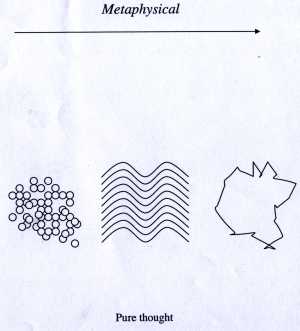

Physicist Cameron Smith explains, in word and gesture, why water floats as Ice:
OK, the water’s going like this, in liquid form (hands fluidly move around close together), like the water molecules do. And then when it freezes, it locks up (hands move further apart from each other and stop), leaving more space between each molecule.
Ice is lighter than water because its molecules are further apart, making ice less dense than water.
A small video clip of this interaction was viewed frame by frame to analyse the movement qualities of hands gestures to construct an animation of ice forming.
.
.
Reply
On 20-08-07 Aidan Davis Emailed a response to this animation.
His introductory words floated in lengths across the screen,
in lines fragmented by some quirk in my machine.
Like ice sliced and rearranged by breakers,
lines of thought were cut off jagged.
Rounding the edges,
I hoped the lines
would still…
hold form.
.
I can see his words etched in glass:
Icebergs physical and metaphysical.
:
“Ice is lighter than water because its molecules are further apart, making ice less dense than water.”
.
.
Thoughts are much more dense than water, they are not easily manipulated like water.
If thoughts translated into language as water then they are heavier.
Maybe language is the victim?
Words are burdened and weighed down by thoughts
which were once lighter but due to the process of( thoughts to words),
are now much heavier.
If we can lighten thoughts
without out loosing the concentration of meaning contained within
then we would be able to translate them
without words being so weighed down.
.
Thoughts are much like ice.
When in a raw state they are odd shaped
with jagged edges and passage ways.
The human body is designed in a symmetrical way.
I figure that thoughts, as shapes which conjure and evoke,
are not designed to be exerted through the human body
as we are not designed in such a way
that allows us to release raw jagged thoughts.
This is why we must globally warm our thoughts (the use of language),
smoothing out edges and creases
eventually melting it into a large mass of homogenous particles,
water.
Water is then easily manipulated and directed
which allows us to translate what is left of our thought
into a single stream of once solid ideas,
now mindless dribble.
The loss of shape
takes away the identity/individual meaning
of the once raw thought
(product of imagination),
now lost
in linear fashion
unrecognisable
as a product
of the imagination.
.
Thank You
Aidan
.
THE TEXTS:
.
Process of thought
When frozen
Their shape is sharp
Jagged edges slicing.
Giant icebergs growing
In coldness of oceanic minds
Only tips emerge, the purity submerged
hollow jagged cathedrals of alabaster white
an ethereal blue entices lustre of buoyant mountains
Floating further from home, murmurs and temperature
hairline cracks, a spectre of majestic purity
fracturing and splintering, becoming
contextual representations.
Melting, deliquesce
Lost in lilac
.
Icebergs
Raw untamed
Thoughts contained
Within shapes, products
of the imagination, restricted
by the confines of language, words.
The true purity of unsubjected thought hidden.
Behind carefully deranged symbols and punctuation
Complete communication of pure thought is impossible.
The global warming of thoughts into language. Smoothing
Edges and creases into a homogenous disembodied
thought, now easily manipulated within the
confines of language. Single streams
of once pure thoughts, now
linear, unrecognisable.
.
Physical Metaphysical
THE IMAGES:
Here is an interactive scientific animation allowing you to experiment with rates of freezing and melting water. You can key in different numbers to alter the temperature, and watch how the behaviour of water and ice water molecules changes.
Two things happen when ice and water are placed in contact:
* Molecules on the surface of the ice escape into the water (melting), and
* molecules of water are captured on the surface of the ice (freezing).When the rate of freezing is the same as the rate of melting, the amount of ice and the amount of water won’t change on average (although there are short-term fluctuations at the surface of the ice). The ice and water are said to be in dynamic equilibrium with each other. The balance between freezing and melting can be maintained at 0°C, the melting point of water, unless conditions change in a way that favors one of the processes over the other.
